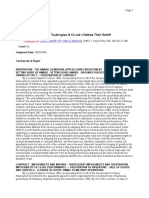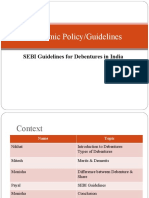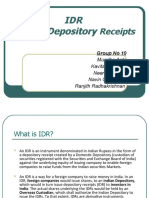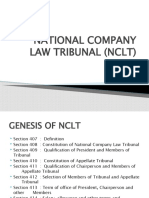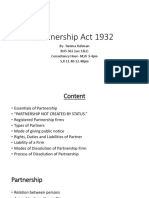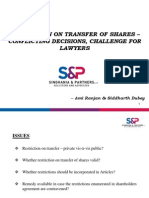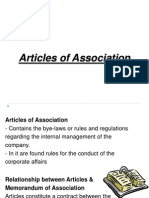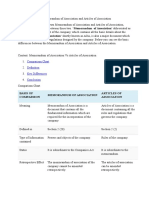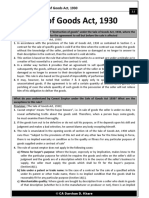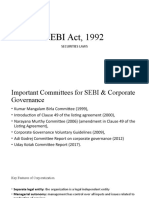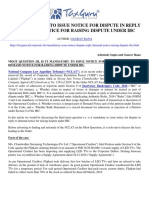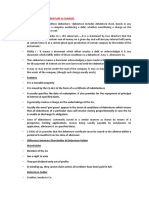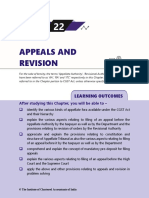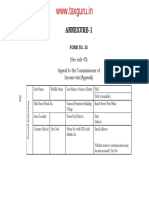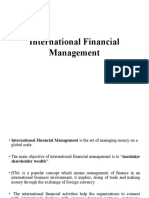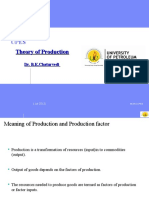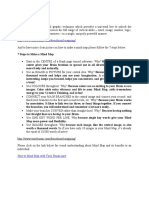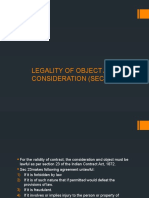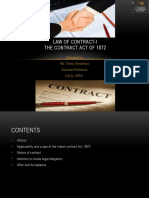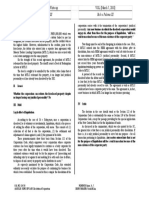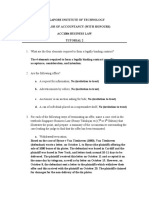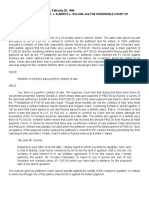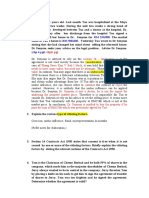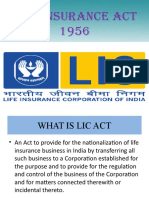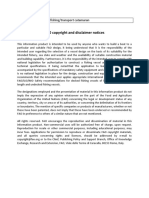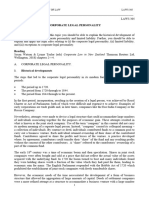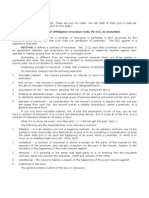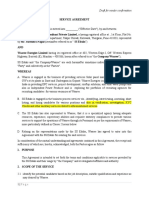0 ratings0% found this document useful (0 votes)
220 viewsDebentures
Debentures
Uploaded by
deepaksinghalThis document discusses debentures and floating charges. Some key points:
- Debentures are documents that evidence a debt or acknowledge a debt of a company. They usually specify repayment of principal and interest and often create a charge over company assets.
- There are different types of debentures including registered, bearer, perpetual, redeemable, secured, unsecured, and convertible debentures. Convertible debentures give the option to convert to equity or preference shares.
- A floating charge is an equitable charge over a class of changing company assets that remains dormant until certain events, allowing the company to deal with assets in the ordinary course of business. A floating charge crystallizes
Copyright:
© All Rights Reserved
Available Formats
Download as PPTX, PDF, TXT or read online from Scribd
Debentures
Debentures
Uploaded by
deepaksinghal0 ratings0% found this document useful (0 votes)
220 views28 pagesThis document discusses debentures and floating charges. Some key points:
- Debentures are documents that evidence a debt or acknowledge a debt of a company. They usually specify repayment of principal and interest and often create a charge over company assets.
- There are different types of debentures including registered, bearer, perpetual, redeemable, secured, unsecured, and convertible debentures. Convertible debentures give the option to convert to equity or preference shares.
- A floating charge is an equitable charge over a class of changing company assets that remains dormant until certain events, allowing the company to deal with assets in the ordinary course of business. A floating charge crystallizes
Original Description:
Debentures
Copyright
© © All Rights Reserved
Available Formats
PPTX, PDF, TXT or read online from Scribd
Share this document
Did you find this document useful?
Is this content inappropriate?
This document discusses debentures and floating charges. Some key points:
- Debentures are documents that evidence a debt or acknowledge a debt of a company. They usually specify repayment of principal and interest and often create a charge over company assets.
- There are different types of debentures including registered, bearer, perpetual, redeemable, secured, unsecured, and convertible debentures. Convertible debentures give the option to convert to equity or preference shares.
- A floating charge is an equitable charge over a class of changing company assets that remains dormant until certain events, allowing the company to deal with assets in the ordinary course of business. A floating charge crystallizes
Copyright:
© All Rights Reserved
Available Formats
Download as PPTX, PDF, TXT or read online from Scribd
Download as pptx, pdf, or txt
0 ratings0% found this document useful (0 votes)
220 views28 pagesDebentures
Debentures
Uploaded by
deepaksinghalThis document discusses debentures and floating charges. Some key points:
- Debentures are documents that evidence a debt or acknowledge a debt of a company. They usually specify repayment of principal and interest and often create a charge over company assets.
- There are different types of debentures including registered, bearer, perpetual, redeemable, secured, unsecured, and convertible debentures. Convertible debentures give the option to convert to equity or preference shares.
- A floating charge is an equitable charge over a class of changing company assets that remains dormant until certain events, allowing the company to deal with assets in the ordinary course of business. A floating charge crystallizes
Copyright:
© All Rights Reserved
Available Formats
Download as PPTX, PDF, TXT or read online from Scribd
Download as pptx, pdf, or txt
You are on page 1of 28
Debentures
Mrs. Shruti Reddy,
CoLS, UPES
Meaning and Definition
• S. 2(30): “Debenture includes debenture stock,
bonds, or any other instrument of a company
evidencing a debt, whether constituting a charge on
the company’s assets or not”.
• Levy v. Abercorris Co. [1888] Ch.D. 260-4:
“debenture means a document which either creates
a debt or acknowledges it and document which
fulfils either of those conditions in a debenture”
• Gower, L C B: “debenture is a name applied to
certain types of documents evidencing an
indebtedness which is normally but not necessarily
secured by a charge over property”
Meaning and Definition
• Every document creating or acknowledging an
indebtedness of the company, until redeemed-
debenture
Characteristic features of Debenture
1. Movable property [S. 44]
2. Issued by the company and in the form of a
certificate of indebtedness
3. Usually specifies the date of redemption
4. Provides for repayment of principal and
interest at specified date/s
5. Generally creates a charge on the undertakings
of the company
• Significance of the term “pari passu”
Debenture stock
• Creation of one loan fund
• Instead of individual debentures, debenture
stock may be created divisible among class of
lenders
• Instead of separate debts, debenture certificate
reflects part of the whole loan to which lender is
entitled
• Debenture includes debenture stock
Debenture Debenture Stock
Legally transferrable as one entity Can be sub divided and transferred
in any fractions that the holder
wishes
May or may not be fully paid Fully paid
Distinction between shareholder and
debenture holder
Shareholder Debenture holder
• Member of the company • Lender of the company
• Right to vote • No such right [S. 71 (2)]
• Dividend driven by profits • Entitled to fixed rate of
interest independent of profits
• Winding up: not prioritized • Winding up: prioritized
• Dividend isn’t treated as • Interest on debentures is
charge on profits charge against profits,
deducted from revenue for
calculating tax liability
Kinds of Debentures
1. Registered debentures:
• Debentures payable to registered holders
• Names appear in the register of debenture holders
• Transferable in the same way as shares or in
accordance with conditions endorsed on their back
• Consists of 2 parts:
a. Covenants by the company to pay principal and
interest
b. Endorsed conditions (term of loan)
• Pari passu or in order of issue if pari passu clause
missing
Kinds of Debentures
2. Bearer debentures:
• Transferable by delivery (similar to share
warrants); acquires characteristic of a
negotiable instrument
• Regn may be avoided by issuing debentures
payable to bearer - register need not be
maintained of such holders
• Such holder may apply for winding up if not
paid
• Cannot be questioned on acquisition of
debenture
• Interest paid by means of attached coupons
Kinds of Debentures
3. Perpetual or Irredeemable debentures:
• Contains no clause as to payment
• Contains clause that it shall not be paid back
• “Once a mortgage, always a mortgage”- Oliver, M C
• Rule: Once principal or interest is paid, property
may be redeemed
• Section 120, Companies Act, 1956: Exception to
the rule: debentures can be made perpetual, loan
may be paid on winding up or a long period of time
• No corresponding provision under Companies Act,
2013, thus, fresh irredeemable debentures can’t be
issued
Kinds of Debentures
4. Redeemable debentures:
• Issued for a specified period of time u/S. 71 and
corresponding rules
• Right to pay back as stipulated and redeem
property
• Re-issue of redeemed debentures (Section 121,
Companies Act, 1956): AoA should permit it; no
other conditions contrary to it; no intention to
cancel redeemed debentures- debentures may
be kept alive for re-issue; no corresponding
provision in Companies Act, 2013
Kinds of Debentures
5. Naked/ unsecured debentures:
- debentures may be issued without any charge on
company’s assets
- mere acknowledgement of debt
- creates no rights beyond those of ordinary unsecured
creditors
- Unsecured debentures treated as deposits; thus to
confirm with provisions applicable to public deposits
6. Convertible debentures: option given to debenture
holders to convert it into equity or preference shares at
stated rates of exchange, after a certain period;
requirement of special resolution for issue- S. 71
Cannot be reconverted into debentures.
Kinds of Debentures
• Classification on basis of convertibility:
1. Fully convertible debentures (FCDs):
- Debentures convertible into equity shares of co. on
expiry of certain specified period/s
- Conversion after 18 but before 36 months of
allotment: optional on part of debenture holders in
terms of SEBI guidelines
- After 36 months: put and call option to be exercised
2. Non- convertible debentures (NCDs):
- Right to convert debentures into equity shares not
conferred on holder
- Debentures redeemed at expiry of specified period
Kinds of Debentures
3. Partly convertible debentures (PCDs)
- Two parts- convertible and non convertible
- Convertible: debentures converted into equity
shares at expiry of certain period
- Non convertible: debentures redeemed at
expiry of certain period
Features of Convertible Debentures
1. Conversion into specified or unspecified no. of equity
shares at the end of specified period
2. Conversion Price/ Conversion Ratio: ratio at which
debentures are exchanged for shares
3. Calculation of Conversion price/ratio and Conversion
premium: dividing face value of debenture by its
conversion price
4. Fully or partly convertible
5. May be converted in one or more stages
6. Credit rating of debentures- if conversion after 18
months
7. Interest paid as per market forces; interest rates
deregulated after 1991
8. Listed on stock exchange
Floating Charge
• S. 2(30):A charge may or may not be created on co.’s
assets while issuing debentures [S. 2(16)- charge
includes mortgage]
• 2 kinds of charges may be created:
a.Fixed charge
b.Floating charge
• Fixed charge: mortgage created on definite or specific
assets of co.- permanent- land, building, heavy
machinery; co. loses right to transfer property
unencumbered without sanction of charge holder;
possession continues with co. though
• Floating charge: created on property which is of liquid
nature, assets keep changing, need to create fresh charge
every time the property turns in course of business;
sanction of lender not required to dispose the property;
floating charge does not get attached to any specific
property till it crystallizes
Floating Charge
• Characteristics of floating charge:
Yorkshire Woolcombers’ Assn Ltd., Re ([1903] 2 Ch 284)
1. It should be a charge upon a class of assets both present and
future
2. Class of assets charged must be one which in ordinary course
of business of co. would change from time to time
3. It should be obvious that unless action is taken by mortgagee,
the co. shall have right to use assets comprised in charge in
ordinary course of its business
Government Stock Co. v. Manila Railway [1897] A.C. 81
“A floating charge is an equitable charge on the assets for the
time being of a going concern. It attaches to the subject charged
in the varying conditions in which it happens from time to time.
It is the essence of such a charge that it remains dormant until
the undertaking ceases to be a going concern or until the person
in whose favour the charge is created, intervenes. This right to
intervene may of course, be suspended by agreement. But, if
there is no agreement of suspension, he may exercise his right
whenever he pleases after default”.
Floating Charge
• Difference between fixed charge and floating charge-
degree of control over the property which charge
holder exercises
• Construction of instrument of charge: intention of
parties should be focused on
• Before crystallization of floating charge co. can
deal/dispose assets of co. in ordinary course of
business
• Further floating charge cannot be created (Re
Benjamin Cpe & Sons, [1914] 1 Ch. 800)
• Can be created only by incorporated co.- created by
deed- must be regd with RoC
Crystallization of floating charge
• Debentures with undertaking to pay principal
sum at specified date with interest in meantime
• When assets seized in this manner- called as
crystallization of charge
• Government Stock Investment Co. Ltd. v.
Manila Railway Co. Ltd., [1897] A.C. 81:
mortgage having priority over floating charge
• Floating charge may be created only by an
incorporated body; must be created by a deed
and registered with RoC
Crystallization of floating charge
• Instances of crystallization of floating charge:
1. When co. goes into liquidation
2. When co. ceases to carry on business
3. When creditors/debenture holders enforce the
security
4. On the happening of specified event in the
deed
Effect of winding up on
Floating Charge (S. 332)
• Validity of floating charge
-floating charge created 12 months immediately
before commencement of winding- invalid
-Exceptions:
a. If co. was solvent after creation of charge; and
b.Charge valid to the extent to which any cash
was paid to co. under the charge
-Objective: to prohibit insolvent co.s to create
charge
Registration of Charges (S. 77)
• Co. authorised to borrow may create charge (even on
uncalled capital) subject to MoA and AoA
• Co. to register charge created on any property within 3o
days of its creation in prescribed form, manner with
prescribed fee
• Extension of time up to 300 days on completion of 30
days- addl fee if co. satisfies RoC it had sufficient reasons
for the delay
• Further extension of time: failure to register on expiry of
300 days, appln to CG u/S. 87
• Charge created by decree of court of law- beyond ambit
of S. 125
• On additional fee & on sufficient grounds for delay- 30
days extension may be given by RoC
Particulars with the Registrar
• Every instrument/ deed creating charge to be
verified
- Property wholly situated outside India:
verification as true copy by co./ co. offr./ person
interested in mortgage
- Property wholly/ partly situated in India: co. offr./
pub. offr.
• Failure to deliver particulars of charge- validity of
charge not affected (T R Thayagarajan v. Official
Liquidator [1960] 30 Comp. Cas. 481 (Mad)
Particulars to be filed with the
Registrar
1. Date and description of the instrument creating charge
2. Amount secured by charge
3. Short particulars of property charged; if property
charged subject to charge- date of acquisition of
property
4. Gist of terms, conditions, extent & operation of charge
5. Names, addresses and description of persons entitled
to charge
6. Date and description of instrument modifying charge
7. All details of modification
Issue of Debentures
• Prospectus/ letter of offer
• Issue of debenture certificates [S. 56(4)]: within 06 months from date
of allotment; default [S. 56(6)]- co. (25,000/- upto 05 lakh); officer
(10,000/- upto 01 lakh)
• Issue of Debentures [S. 71]:
Convertible debentures- special resolution at GM
No voting rights
Secured redeemable debentures
a. Date of redemption- not to exceed 10 yrs from date of issue
b. Companies with date of redemption not exceeding 30 yrs:
i. Companies engaged in setting up Infrastructure Projects;
ii. Infrastructure Finance Companies
iii.Infrastructure Debt Fund Non Banking Financial Companies
c. Debenture to be secured by creation of charge on property
sufficient for repayment
d. Appointment of debenture trustee: before issue of prospectus/
letter of offer and not later than 60 days after allotment
e. Creation of security on specific movable/ immovable property of
the company
Contd.
Debenture Redemption Reserve Account: out of
profits, available for payment of dividends; amount to be
utilized only for redemption of debentures:
a. DRR not required- All India Financial Institutions, both
pub and pvt placed debentures
b. Other Financial Institutions- DRR same as NBFC regd
with RBI
c. NBFC & Housing Finance Companies (regd with National
Housing Bank): 25% of value of debentures issued
through pub issue and no DRR for pvt placed issue
d. Other companies (including infra and manufacture
companies): 25% of value of debentures issued through
pub issue and pvt placed issue
e. Unlisted companies: 25% of value of debentures issued
through pvt placed issue
Contd.
Minimum amount to be maintained in DRR: on or
before April 30 every year: create/ invest/ deposit- sum not
less than 15% of amount maturing during the current
financial year- following methods
a. Deposits with Scheduled Banks, free form charge or lien;
b. Unencumbered Securities of CG/SG;
c. Unencumbered Securities under Indian Trusts Act, 1882;
d. Unencumbered Bonds issued by any other company under
Indian Trusts Act, 1882;
e. Amount invested not to be used for any purpose other
than redemption of debentures maturing as above; at no
time DRR to fall below 15%
f. Partly convertible debentures- DRR to be created for non
convertible portion of debentures
Contd.
Public Offer: if to more than 500, appointment of
debenture trustee- mandatory
Debenture trust deed- void, if clause of exemption of
liability of trustee or clause of indemnification present;
3/4th in value of debenture holders may subject liability
to exemptions agreed by them in a meeting held for that
purpose
Payment of interest & Redemption of debentures: acc to
T&C of issue
Insufficiency of assets: debenture trustee to file a
petition to NCLT; NCLT may impose restrictions on
incurring further liabilities by company on its assets
Contd.
Failure of redemption and payment of
interest: application by any/ all debenture
holders/ debenture trustee to NCLT; NCLT may
pass orders to pay forthwith
Default in complying with NCLT order: offr.
responsible- imprisonment upto 03 years OR fine
not less than 02 lakh INR, upto 05 lakh OR both
Contract with company- payment of debentures-
may be enforced by decree for specific performance
Procedure for security in secured debentures, form
of debenture trust deed, process of inspection of
trust deed by debenture holders+ copies, quantum
of debenture redemption reserve, etc- CG
You might also like
- Download full Jobs to Be Done Playbook The Jim Kalbach ebook all chaptersDocument34 pagesDownload full Jobs to Be Done Playbook The Jim Kalbach ebook all chapterstayomadob100% (3)
- Tsakiroglou & Co LTD V Noblee Thorl GMBHDocument4 pagesTsakiroglou & Co LTD V Noblee Thorl GMBHTimishaNo ratings yet
- Essential Soft Skills for Lawyers: What They Are and How to Develop ThemFrom EverandEssential Soft Skills for Lawyers: What They Are and How to Develop ThemNo ratings yet
- Draft 3 Amrapali Trilegal PresentationDocument16 pagesDraft 3 Amrapali Trilegal PresentationdivyaniNo ratings yet
- EssayDocument2 pagesEssayKai RuNo ratings yet
- Chap 13 Order Confirming PlanDocument2 pagesChap 13 Order Confirming PlanRobert GilstrapNo ratings yet
- P&I Certificate of EntryDocument6 pagesP&I Certificate of EntryWILLINTON HINOJOSA0% (1)
- DebenturesDocument12 pagesDebenturesPayal Patel100% (2)
- The West Bengal Land Reforms Act, 1955 PDFDocument121 pagesThe West Bengal Land Reforms Act, 1955 PDFaditya dasNo ratings yet
- Faculty of Law Jamia Millia Islamia: Insurance, Banking & Negotiable Instrument Insurable InterestDocument11 pagesFaculty of Law Jamia Millia Islamia: Insurance, Banking & Negotiable Instrument Insurable InterestPankaj KumarNo ratings yet
- Dividend Under Companies Act, 2013: CS Divesh GoyalDocument12 pagesDividend Under Companies Act, 2013: CS Divesh GoyalAbhinay KumarNo ratings yet
- Debenture Certificate 380Document2 pagesDebenture Certificate 380girivalamsupermarketNo ratings yet
- The Companies Act, 2013: Learning OutcomesDocument40 pagesThe Companies Act, 2013: Learning OutcomesYogesh sharmaNo ratings yet
- IDR Indian Depository: ReceiptsDocument16 pagesIDR Indian Depository: Receiptstakshu29No ratings yet
- Indian Partnership ACT, 1932Document12 pagesIndian Partnership ACT, 1932Deepika GuptaNo ratings yet
- Meetings ProjectDocument19 pagesMeetings ProjectPriyaranjan SinghNo ratings yet
- National Company Law Tribunal (NCLT)Document18 pagesNational Company Law Tribunal (NCLT)Jinal SanghviNo ratings yet
- Winding Up of A CompanyDocument16 pagesWinding Up of A CompanysanamahewishNo ratings yet
- Company LawDocument15 pagesCompany Lawramesh.kNo ratings yet
- 2.conditions and WarrantiesDocument43 pages2.conditions and Warrantieskunal kathuruaNo ratings yet
- Notes of Income From House PropertyDocument12 pagesNotes of Income From House PropertyKomal MenghaniNo ratings yet
- Kinds of ProspectusDocument5 pagesKinds of ProspectusPriya KumariNo ratings yet
- Partnership Act 1932: By-Tanima Rahman BUS 361 (Sec 1&2) Consultancy Hour - M, W 3-4pm S, R 11.40-12.40pmDocument50 pagesPartnership Act 1932: By-Tanima Rahman BUS 361 (Sec 1&2) Consultancy Hour - M, W 3-4pm S, R 11.40-12.40pmTanvir Rasel100% (1)
- Restriction On Transfer of SharesDocument46 pagesRestriction On Transfer of SharesSanjay MauryaNo ratings yet
- Primary Market IntermediariesDocument12 pagesPrimary Market IntermediariesAnonymous LMJCoKqNo ratings yet
- Partnership Act 1932Document32 pagesPartnership Act 1932Padma TotaNo ratings yet
- Doctrine of Indoor Management and Ultra ViresDocument7 pagesDoctrine of Indoor Management and Ultra ViresPadma Gawde100% (1)
- Articles of AssociationDocument13 pagesArticles of Associationrainaanu100% (1)
- Difference Between Memorandum of Association and Articles of AssociationDocument4 pagesDifference Between Memorandum of Association and Articles of AssociationSuresh JayaramaNo ratings yet
- Insurance Act 1938 IIBSDocument23 pagesInsurance Act 1938 IIBSbapparoyNo ratings yet
- Companies Act 2013 Full Summary Notes PDFDocument50 pagesCompanies Act 2013 Full Summary Notes PDFAbhishekMittalNo ratings yet
- Banking Regulation Act, 1949: HistoryDocument18 pagesBanking Regulation Act, 1949: HistoryriddhisanghviNo ratings yet
- Company Law - Unit IIIDocument42 pagesCompany Law - Unit IIIShazadi SadaquthNo ratings yet
- Sale of Goods Act 1931Document17 pagesSale of Goods Act 1931Aarav TripathiNo ratings yet
- Winding Up of CompanyDocument5 pagesWinding Up of Companyhrprt_sngh1No ratings yet
- Winding Up of A CompanyDocument13 pagesWinding Up of A CompanyLogan DavisNo ratings yet
- LLP Agreement - LogoriDocument16 pagesLLP Agreement - LogoriHarish BhandariNo ratings yet
- Consequences of Winding Up of CompaniesDocument4 pagesConsequences of Winding Up of CompaniesKeshav MaheshwariNo ratings yet
- Dissolution of Firm and Dissolution of PartnershipDocument27 pagesDissolution of Firm and Dissolution of Partnershippratham Kadam100% (1)
- SEBI Act, 1992Document26 pagesSEBI Act, 1992saif aliNo ratings yet
- Tandon Committee Report On Working CapitalDocument4 pagesTandon Committee Report On Working CapitalMohitAhuja100% (1)
- Is It Mandatory To Issue Notice For Dispute in Reply To Demand Notice For Raising Dispute Under IBC - Taxguru - inDocument7 pagesIs It Mandatory To Issue Notice For Dispute in Reply To Demand Notice For Raising Dispute Under IBC - Taxguru - inSandeep KhuranaNo ratings yet
- IRDADocument9 pagesIRDAprerna1891No ratings yet
- Prospectus Is Not An Offer But An Invitation To OfferDocument24 pagesProspectus Is Not An Offer But An Invitation To OfferGaurav NavaleNo ratings yet
- Role of Official Liquidator in Winding Up: Submitted by Arathy Nair, CS FinalistDocument5 pagesRole of Official Liquidator in Winding Up: Submitted by Arathy Nair, CS FinalistDhruba Debnath100% (1)
- Memorandum of AssociationDocument17 pagesMemorandum of AssociationFaraz Siddiqui100% (1)
- PPT On DVRDocument20 pagesPPT On DVRParitosh Rachna GargNo ratings yet
- Relations of Partners Inter SeDocument8 pagesRelations of Partners Inter SeRahul kumarNo ratings yet
- Bailment and PledgeDocument20 pagesBailment and PledgeIndrajNo ratings yet
- Duties of The PartnersDocument4 pagesDuties of The PartnersAnusree ArunNo ratings yet
- The Presentation Is Only Illustrative and Not ExhausitiveDocument97 pagesThe Presentation Is Only Illustrative and Not ExhausitiveUjjwal AnandNo ratings yet
- Winding Up Under Companies ActDocument76 pagesWinding Up Under Companies ActSher Singh YadavNo ratings yet
- Directors - Powers, Duties, and Liabilities - Winding Up of CompanyDocument24 pagesDirectors - Powers, Duties, and Liabilities - Winding Up of CompanyDr A. K. SubramaniNo ratings yet
- Passing of Board Resolution by Circulation Under Section 289Document3 pagesPassing of Board Resolution by Circulation Under Section 289Rajagopal ChellappanNo ratings yet
- Role of PromoterDocument10 pagesRole of PromoterMewish FzNo ratings yet
- Borrowing PowersDocument11 pagesBorrowing PowersSaptak RoyNo ratings yet
- Discharge of TortsDocument2 pagesDischarge of TortsAdeelNo ratings yet
- Capital Market ReformsDocument8 pagesCapital Market ReformsRiyas ParakkattilNo ratings yet
- Contract Law - Rights and Duties of PartnersDocument28 pagesContract Law - Rights and Duties of PartnersAditya AnandNo ratings yet
- Unit 5 - Indian Partnership Act, 1932Document29 pagesUnit 5 - Indian Partnership Act, 1932Prabhnoor KaurNo ratings yet
- Company LawDocument105 pagesCompany LawSrinivasa RaoNo ratings yet
- Recovery of Debts Due To Banks and Financial Institutions With Reference To DRT and DRAT: A Comparative Analysis of India and NepalDocument15 pagesRecovery of Debts Due To Banks and Financial Institutions With Reference To DRT and DRAT: A Comparative Analysis of India and NepalAnonymous NKoOWWNo ratings yet
- Auditors Qualification 2.1Document39 pagesAuditors Qualification 2.1Sayraj Siddiki AnikNo ratings yet
- Investigation into the Adherence to Corporate Governance in Zimbabwe’s SME SectorFrom EverandInvestigation into the Adherence to Corporate Governance in Zimbabwe’s SME SectorNo ratings yet
- Unit 8n9Document7 pagesUnit 8n92050221 KUSHAGRA SHAHINo ratings yet
- Appeals and Revision: After Studying This Chapter, You Will Be Able ToDocument39 pagesAppeals and Revision: After Studying This Chapter, You Will Be Able TodeepaksinghalNo ratings yet
- Annexure-1: (See Rule 45) Appeal To The Commissioner of Income-Tax (Appeals)Document11 pagesAnnexure-1: (See Rule 45) Appeal To The Commissioner of Income-Tax (Appeals)deepaksinghalNo ratings yet
- 1M 183 AdjudicationofTaxRel - Disputes (Hons-8 - 20190415083537.975 - XDocument6 pages1M 183 AdjudicationofTaxRel - Disputes (Hons-8 - 20190415083537.975 - XdeepaksinghalNo ratings yet
- Organizational Behaviour by DR Janmejay Senapati 09a447Document853 pagesOrganizational Behaviour by DR Janmejay Senapati 09a447deepaksinghalNo ratings yet
- IFM N RMDocument89 pagesIFM N RMdeepaksinghalNo ratings yet
- Theory of Produc - 1Document15 pagesTheory of Produc - 1deepaksinghalNo ratings yet
- The First Conditional - (Explanation, Exercise & Ans)Document3 pagesThe First Conditional - (Explanation, Exercise & Ans)deepaksinghalNo ratings yet
- Legal Method & Legal ReasoningDocument2 pagesLegal Method & Legal ReasoningdeepaksinghalNo ratings yet
- 4.1.1 Mind MappingDocument1 page4.1.1 Mind MappingdeepaksinghalNo ratings yet
- 6 Legality of Object and Consideration (Sec 23Document18 pages6 Legality of Object and Consideration (Sec 23deepaksinghalNo ratings yet
- Kinds of A Contract: Prepared by Ms. Charu Srivastava Assistant Professor Cols, UpesDocument34 pagesKinds of A Contract: Prepared by Ms. Charu Srivastava Assistant Professor Cols, UpesdeepaksinghalNo ratings yet
- 1 Law of Contract-IDocument174 pages1 Law of Contract-IdeepaksinghalNo ratings yet
- PARTNERSHIP LiquidationDocument17 pagesPARTNERSHIP LiquidationMark Joseph E VisdaNo ratings yet
- Muntiariani NTUC Income-InsuranceDocument2 pagesMuntiariani NTUC Income-InsuranceSyscom PrintingNo ratings yet
- Intellectual Property LawDocument8 pagesIntellectual Property LawbooksxdreamsNo ratings yet
- (Corp) 350 - Rich V Paloma III - LimDocument1 page(Corp) 350 - Rich V Paloma III - LimJosiah LimNo ratings yet
- SIT - Tutorial.2 (Offer)Document3 pagesSIT - Tutorial.2 (Offer)sharon limNo ratings yet
- FM2 Exam Study GuideDocument7 pagesFM2 Exam Study GuideMatthew BrueningNo ratings yet
- Franchise CostDocument4 pagesFranchise CostCariza Kaila FelicitasNo ratings yet
- Equiti Seychelles Refer A Friend 10.10.23Document2 pagesEquiti Seychelles Refer A Friend 10.10.23PrathameshNo ratings yet
- BIR Ruling No. 15-2003Document4 pagesBIR Ruling No. 15-2003d-fbuser-49417072No ratings yet
- Contrato Mig Export Mid Wings para VicenteDocument15 pagesContrato Mig Export Mid Wings para VicentemariaNo ratings yet
- © The Institute of Chartered Accountants of IndiaDocument8 pages© The Institute of Chartered Accountants of IndiaKartik GuptaNo ratings yet
- Get Organic Synthesis The Disconnection Approach 2nd Edition PDF ebook with Full Chapters NowDocument14 pagesGet Organic Synthesis The Disconnection Approach 2nd Edition PDF ebook with Full Chapters Nowlanjarclaudi100% (2)
- Form of Contracts - Clarin v. Rulona (1984)Document1 pageForm of Contracts - Clarin v. Rulona (1984)Lino MomonganNo ratings yet
- Importance of ConsiderationDocument15 pagesImportance of ConsiderationASIF RAFIQUE BHATTI100% (7)
- Law - T6 Void, Terms, Discharge, RemediesDocument7 pagesLaw - T6 Void, Terms, Discharge, Remedies包子No ratings yet
- Acm Law Final Assessment: 1. Explain The Modes of Transfer Under Transfer of Property ActDocument4 pagesAcm Law Final Assessment: 1. Explain The Modes of Transfer Under Transfer of Property ActRushikesh ChevaleNo ratings yet
- Lic Act 1956Document22 pagesLic Act 1956Arpita ChoudharyNo ratings yet
- TrademarkroomDocument14 pagesTrademarkroomTrade markroomNo ratings yet
- FAO Copyright and Disclaimer Notices: Boat Plan PNG - 5: 8.2 M Fishing/transport CatamaranDocument5 pagesFAO Copyright and Disclaimer Notices: Boat Plan PNG - 5: 8.2 M Fishing/transport CatamaranJoao CalinhoNo ratings yet
- C.A I Assignment: TopicDocument14 pagesC.A I Assignment: TopicArjun AulNo ratings yet
- Open-Source Software License Agreements For HP Laserjet and Scanjet PrintersDocument160 pagesOpen-Source Software License Agreements For HP Laserjet and Scanjet PrintersSlobodan StanicNo ratings yet
- Corporate Personality HandoutDocument18 pagesCorporate Personality HandoutshanhaolihaiNo ratings yet
- Insurance Law ReviewerDocument35 pagesInsurance Law Reviewerisraeljamora100% (4)
- Proposed Agreement Ss Eduks - Waaree (Clean Version)Document5 pagesProposed Agreement Ss Eduks - Waaree (Clean Version)Dinesh SSeduksNo ratings yet
- Template 3Document4 pagesTemplate 3Jose Julian Rojas RamirezNo ratings yet

